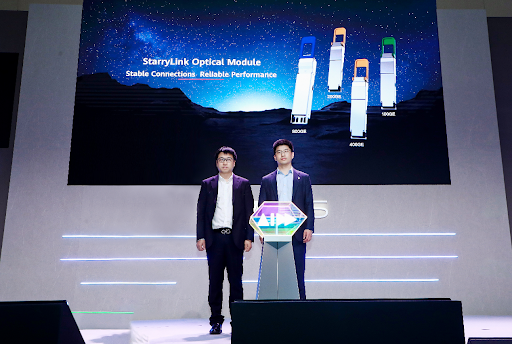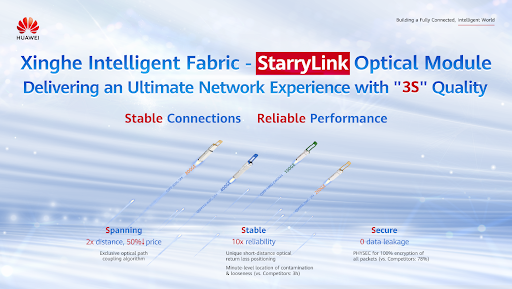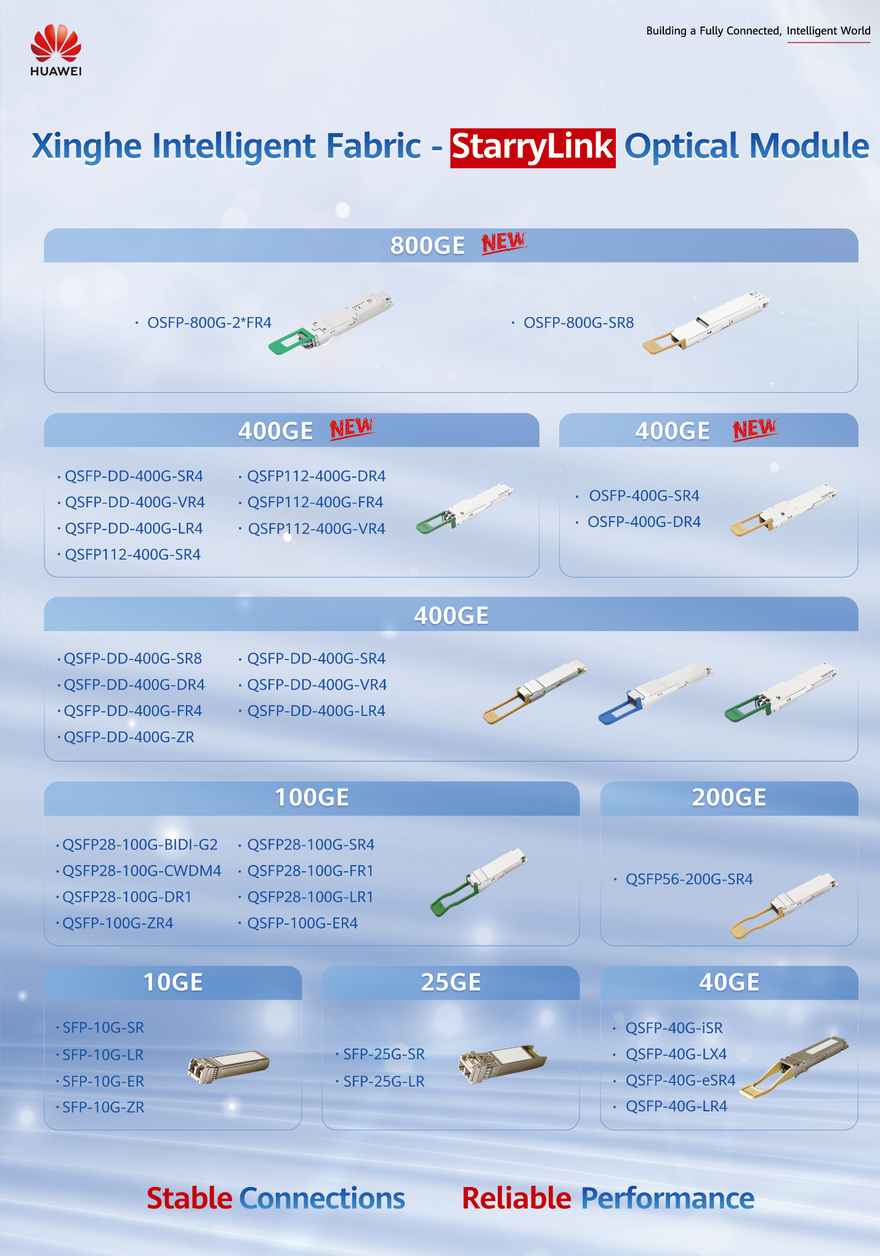As enterprises navigate the currents of digital transformation, they are fundamentally reshaping the way they operate. Data, as the root of innovation in computing, is the key to achieving a seamless transition – if managed thoughtfully.
With data centers at the heart of this digital stream, their role in compute, storage, and networking becomes increasingly vital. As AI clusters rapidly expand, the network of interconnections between spine and leaf nodes grows, necessitating data centers to keep pace by integrating more server racks and points of delivery (PoDs).
With AI models processing unprecedented volumes of parameters, the need for highly reliable, fast, and secure data transmission has never been greater. Yet, traditional optical modules struggle with limited transmission distances, reliability concerns, and security vulnerabilities, creating bottlenecks that disrupt AI-driven innovation.
At MWC 2025, Huawei introduced the StarryLink Series optical modules – a breakthrough solution designed to keep data flowing effortlessly into the future.
The catalyst for expansion
As AI technology advances, the need to collate and process scattered parameters has become increasingly critical. In recent years, large model parameter scales have surged from 10 billion to 100 billion. With AI training now approaching trillions of parameters, the demand for upgrades is further accelerated.
As the rate of the optical module increases, the loss increases, and the transmission distance of the optical module shortens.
As data centers evolve to support larger switching capacities and higher bandwidth, optical modules must also evolve to support more individual PoDs and enable longer transmission distances.
With AI clusters now deploying 10,000 to 100,000 GPUs, optical module reliability has become a major concern. A recent Huawei study found that in a 10,000-GPU cluster, 280 faults occurred annually, of which 70 percent were attributed to issues such as contaminated optical modules and fiber faults. This can lead to costly downtime and disruptions.
Customers should, therefore, consider upgrading to advanced optical modules that support higher data rates per lane. For example, optical modules currently using 56Gbps per lane could transition to 112Gbps per lane for better interconnection of high-capacity switches. This would result in faster, more efficient communication between large-scale data center switches, ultimately contributing to scalability, reliability, and efficiency.
Huawei StarryLink Series optical modules
Unveiled at MWC Barcelona 2025, Huawei’s StarryLink optical modules leverage advanced technologies for efficiency. Huawei’s specialized technology can increase the performance, reliability, and security of the optical modules and provide “3S” quality optical modules.
Huawei’s exclusive optical path coupling algorithm helps effectively increase the transmission distance of optical modules.
As demonstrated at MWC, StarryLink is built on a foundation of “3S” quality: Spanning, stable, and secure. This ensures long transmission distances, high reliability, and robust security.
Spanning: Longer transmission distances
In server access scenarios, Huawei’s short-range optical modules achieve a 100-meter transmission distance for cross-equipment room 400GE interconnections, while industry players typically support 50 meters.
The algorithm also improves access to top-of-rack (TOR) AI training switches, making it easier and more efficient for AI systems to communicate and extend the transmission distance. This is particularly beneficial in AI training environments where large data sets are transferred between servers.
Stable: Reliability in server access
According to Huawei, in short-distance optical return loss locating, its technology quickly and accurately identifies faults caused by dirt and loose fittings within two minutes, as opposed to three hours as standard in the industry.
Huawei’s lane reduction technology, which isolates faulty lanes or lasers to maintain overall module functionality, has significantly improved the reliability of its optical modules – cutting the failure rate from four per mille (four failures in every thousand modules) to just 0.4 per mille (0.4 failures in every thousand modules). This 10-fold improvement in reliability helps ensure that data transmission is more stable and that there are fewer service interruptions in AI training or key services.
Secure: Enhanced security
Exposed fibers that are not properly protected or enclosed are vulnerable to “link eavesdropping,” a major risk for data theft in optical networks. To address this, Huawei provides Physec physical-layer encryption technology, securing data by directly encrypting the bitstreams at the physical layer of the network.
Physec operates at the physical layer (PHY level) – the first layer of the OSI model – providing end-to-end encryption for all Ethernet frames, including headers and inter-frame gaps. This enhanced security guards against traffic analysis attacks.
This allows for 100 percent encryption of data packets without requiring additional bandwidth. Additionally, it can handle out-of-order reassembly, meaning that even if data arrives in a different order, it can still be properly decrypted and assembled.
Physec's physical layer encryption ensures greater foundational security, as it encrypts more detailed information (e.g., frame frequency and length) than MACsec, which operates at the data link layer and leaves certain information unprotected.
Scaling the solution
Building on the success of its StarryLink module portfolio, Huawei has now expanded its offering to over 20 types of optical modules, supporting speeds ranging from 10GE to 800GE in both QSFP (quad small form-factor pluggable) and OSFP (octal small form-factor pluggable) formats.
A key update is the increased availability of 400GE modules, along with the introduction of 800GE modules, designed with OSFP for greater bandwidth, addressing the growing demands of high-performance computing (HPC) and AI-driven workloads.
In 2025, the StarryLink series has expanded from seven to over 20 models, leveraging Huawei’s exclusive technology to deliver unparalleled stability, spanning distances, and security – embodying the 3S advantage. Whether enhancing inter-rack connectivity, optimizing large-scale AI clusters, or fortifying data security, StarryLink Optical Modules ensure that data flows seamlessly into the future.
Looking ahead, Huawei plans to introduce additional models to support even more functions and expand application scenarios, including support for longer transmission distances, continuing to meet the evolving needs of the digital landscape.
For more information, explore Huawei’s data center network here.
More from Huawei
-

Sponsored Huawei launches AI-ready data storage for carriers to embrace AI
The highlights from Dr Peter Zhou's keynote speech at MWC 2025
-

Sponsored Are you ready for the age of future-proof data storage power?
Huawei and Roland Berger release blueprint for storage in the AI era
-

Powering the digital era forward
Huawei Global Data Center Facility Summit 2024



